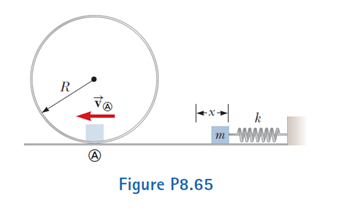
Concept explainers
A block of mass 0.500 kg is pushed against a horizon-tal spring of negligible mass until the spring is compressed a distance x (Fig. P8.65). The force constant of the spring is 450 N/m. When it is released, the block travels along a frictionless, horizontal surface to point Ⓐ, the bottom of a vertical circular track of radius R = 1.00 m, and continues to move up the track. The block’s speed at the bottom of the track is vⒶ = 12.0 m/s, and the block experiences an average friction force of 7.00 N while sliding up the track. (a) What is x? (b) If the block were to reach the top of the track, what would be its speed at that point? (c) Does the block actually reach the top of the track, or does it fall off before reaching the top?

(a)
The value of compression in the spring
Answer to Problem 8.65AP
The value of compression in the spring
Explanation of Solution
Given info: The mass of the block is
The formula to calculate the initial kinetic energy of the block is,
Here,
The initial velocity of the block is 0 as it is at rest then the initial kinetic energy of the block is 0.
The formula to calculate the final kinetic energy is,
Here,
The formula to calculate initial potential energy is,
Here,
The formula to calculate the final potential energy is,
Here,
Thus, the final potential energy of the block is
The formula to calculate the initial energy is,
Here,
The final compression distance is 0 as the spring does not move after striking to the block then the final potential energy is 0.
Substitute
Thus, the initial energy is
The formula to calculate the final energy is,
Here,
Substitute
Thus, the final energy is
From the law of conservation of the energy,
Here,
Substitute
Substitute
Rearrange the above formula for
Substitute
Conclusion:
Therefore, the value of
(b)
The speed of the block at the top of the track.
Answer to Problem 8.65AP
The speed of the block at the top of the track is
Explanation of Solution
Given info: The mass of the block is
The formula to calculate the work done by the frictional force is,
Here,
The formula to calculate the initial kinetic energy of the block is,
Here,
The formula to calculate the final kinetic energy is,
Here,
The formula to calculate initial potential energy is,
Here,
The initial height of the block is 0 as the block is at the bottom of the track then the initial potential energy is 0.
The formula to calculate the final potential energy is,
Here,
Substitute
Thus, the final potential energy of the block is
The formula to calculate the initial energy is,
Here,
Substitute
Thus, the initial energy is
The formula to calculate the final energy is,
Here,
Substitute
Thus, the final energy is
The formula to calculate the law of conservation of energy is,
Here,
Substitute
Substitute
Rearrange the above formula for
Substitute
Conclusion:
Therefore, the speed of the block at the top of the track is
(c)
Whether the block reach the top of the track or fall off before reaching the top.
Answer to Problem 8.65AP
The block stays at the top of the track.
Explanation of Solution
Given info: The mass of the block is
The formula to calculate the centripetal acceleration of the block at the top of the track is,
Here,
Substitute
if the centripetal acceleration of the block at the top of the track is less than the acceleration due to gravity then the block fall but centripetal acceleration of the block at the top of the track is greater than the acceleration due to gravity that concludes that the block actually reaches the top of the track.
Conclusion:
Therefore, the block stays at the top of the track.
Want to see more full solutions like this?
Chapter 8 Solutions
Bundle: Physics for Scientists and Engineers, Technology Update, 9th Loose-leaf Version + WebAssign Printed Access Card, Multi-Term
- Plastic beads can often carry a small charge and therefore can generate electric fields. Three beads are oriented such that 92 is between q₁ and 93. The sum of the charge on 9₁ and 92 is 9₁ + 92 = −2.9 µС, and the net charge of the system of all three beads is zero. E field lines 93 92 What charge does each bead carry? 91 92 -1.45 What is the net charge of the system? What charges have to be equal? μC 2.9 ✓ What is the net charge of the system? What charges have to be equal? μC 93 2.9 μεarrow_forwardNo chatgpt pls will upvotearrow_forwardPoint charges of 6.50 μC and -2.50 μC are placed 0.300 m apart. (Assume the negative charge is located to the right of the positive charge. Include the sign of the value in your answers.) (a) Where can a third charge be placed so that the net force on it is zero? 0.49 m to the right of the -2.50 μC charge (b) What if both charges are positive? 0.49 xm to the right of the 2.50 μC chargearrow_forward
- Find the electric field at the location of q, in the figure below, given that q₁ =9c9d = +4.60 nC, q = -1.00 nC, and the square is 20.0 cm on a side. (The +x axis is directed to the right.) magnitude direction 2500 x What symmetries can you take advantage of? What charges are the same magnitude and the same distance away? N/C 226 × How does charge sign affect the direction of the electric field? counterclockwise from the +x-axis 9a 9b % 9 9darrow_forwardwould 0.215 be the answer for part b?arrow_forwardSuppose a toy boat moves in a pool at at a speed given by v=1.0 meter per second at t=0, and that the boat is subject to viscous damping. The damping on the boat causes the rate of speed loss to be given by the expression dv/dt=-2v. How fast will the boat be traveling after 1 second? 3 seconds? 10 seconds? Use separation of variables to solve this.arrow_forward
- What functional form do you expect to describe the motion of a vibrating membrane without damping and why?arrow_forwardIf speed is tripled, how much larger will air drag become for an object? Show the math.arrow_forwardWhat does it tell us about factors on which air drag depends if it is proportional to speed squared?arrow_forward
- What is the net charge on a sphere that has the following? x (a) 5.75 × 106 electrons and 8.49 × 106 protons 4.39e-13 What is the charge of an electron? What is the charge of a proton? C (b) 200 electrons and 109 protons 1.60e-10 What is the charge of an electron? What is the charge of a proton? Carrow_forwardA spider begins to spin a web by first hanging from a ceiling by his fine, silk fiber. He has a mass of 0.025 kg and a charge of 3.5 μC. A second spider with a charge of 4.2 μC rests in her own web exactly 2.1 m vertically below the first spider. (a) What is the magnitude of the electric field due to the charge on the second spider at the position of the first spider? 8.57e3 N/C (b) What is the tension in the silk fiber above the first spider? 0.125 How does the electric field relate to the force? How do you calculate the net force? Narrow_forwardPoint charges of 6.50 μC and -2.50 μC are placed 0.300 m apart. (Assume the negative charge is located to the right of the positive charge. Include the sign of the value in your answers.) (a) Where can a third charge be placed so that the net force on it is zero? 0.49 m to the right of the -2.50 μC charge (b) What if both charges are positive? 0.185 xm to the right of the 2.50 μC chargearrow_forward
 Physics for Scientists and Engineers: Foundations...PhysicsISBN:9781133939146Author:Katz, Debora M.Publisher:Cengage Learning
Physics for Scientists and Engineers: Foundations...PhysicsISBN:9781133939146Author:Katz, Debora M.Publisher:Cengage Learning Principles of Physics: A Calculus-Based TextPhysicsISBN:9781133104261Author:Raymond A. Serway, John W. JewettPublisher:Cengage Learning
Principles of Physics: A Calculus-Based TextPhysicsISBN:9781133104261Author:Raymond A. Serway, John W. JewettPublisher:Cengage Learning Physics for Scientists and Engineers, Technology ...PhysicsISBN:9781305116399Author:Raymond A. Serway, John W. JewettPublisher:Cengage Learning
Physics for Scientists and Engineers, Technology ...PhysicsISBN:9781305116399Author:Raymond A. Serway, John W. JewettPublisher:Cengage Learning College PhysicsPhysicsISBN:9781285737027Author:Raymond A. Serway, Chris VuillePublisher:Cengage Learning
College PhysicsPhysicsISBN:9781285737027Author:Raymond A. Serway, Chris VuillePublisher:Cengage Learning Physics for Scientists and Engineers with Modern ...PhysicsISBN:9781337553292Author:Raymond A. Serway, John W. JewettPublisher:Cengage Learning
Physics for Scientists and Engineers with Modern ...PhysicsISBN:9781337553292Author:Raymond A. Serway, John W. JewettPublisher:Cengage Learning Glencoe Physics: Principles and Problems, Student...PhysicsISBN:9780078807213Author:Paul W. ZitzewitzPublisher:Glencoe/McGraw-Hill
Glencoe Physics: Principles and Problems, Student...PhysicsISBN:9780078807213Author:Paul W. ZitzewitzPublisher:Glencoe/McGraw-Hill





